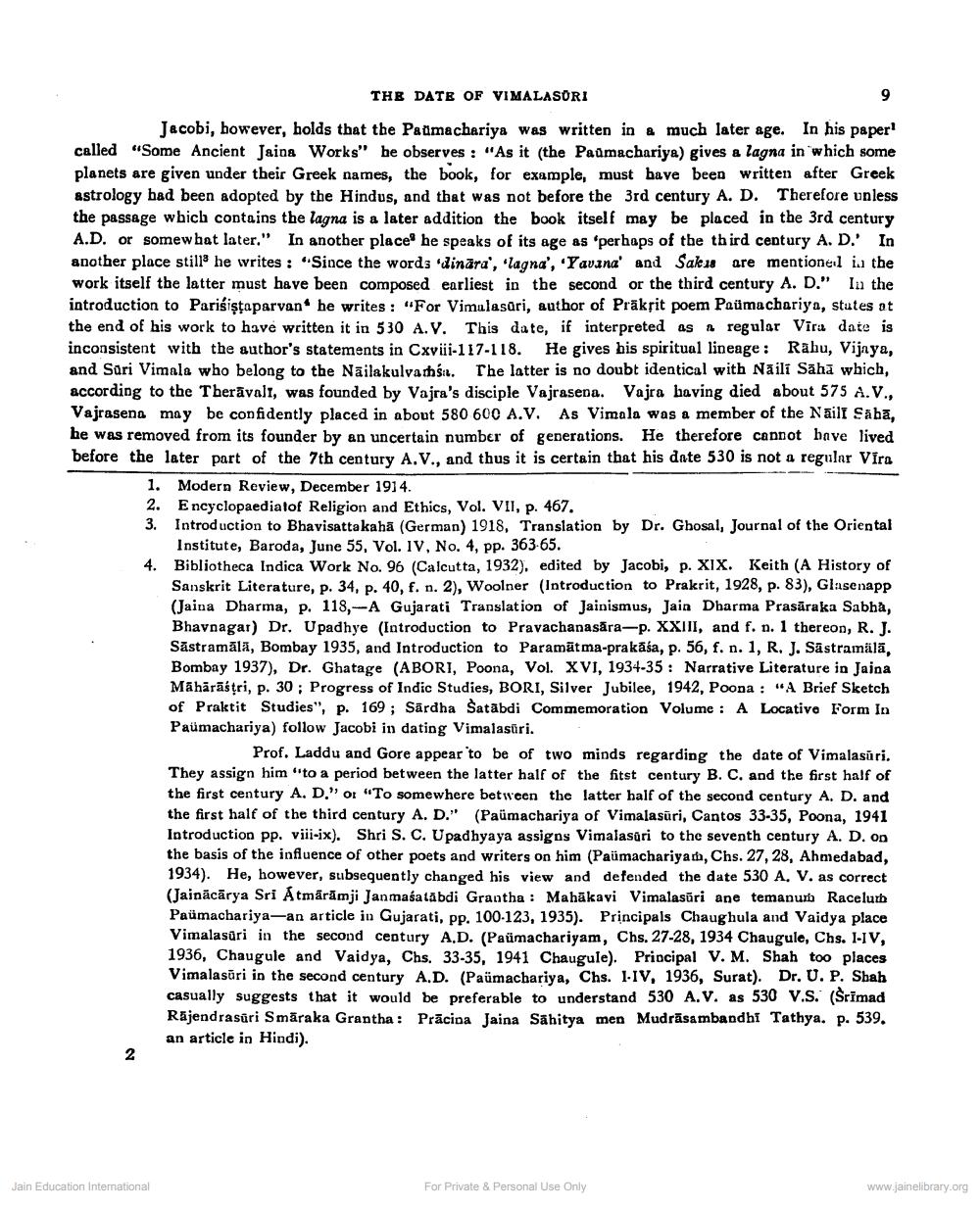________________
THE DATE OF VIMALASORI
Jacobi, however, holds that the Padmachariya was written in a much later age. In his paper! called "Some Ancient Jaina Works" be observes : "As it (the Padmachariya) gives a lagna in which some planets are given under their Greek names, the book, for example, must have been written after Greek astrology bad been adopted by the Hindus, and that was not before the 3rd century A. D. Therefore unless the passage wbich contains the lagna is a later addition the book itself may be placed in the 3rd century A.D. or somewhat later," In another place he speaks of its age as 'perhaps of the third century A. D. In another place still he writes: "Since the words dināra', 'lagna', Yavina' and Saku are mentionel in the work itself the latter must have been composed earliest in the second or the third century A. D." In the introduction to Parisiştaparvan he writes: "For Vimulasari, author of Prakrit poem Paümachariya, stutes at the end of his work to have written it in 530 A.V. This date, if interpreted as regular Vira date is inconsistent with the author's statements in Cxviii-117-118. He gives his spiritual lineage: Rahu, Vijnya, and Sari Vimala who belong to the Nailakulvaths. The latter is no doubt identical with Naili Sähā which, according to the Therāvali, was founded by Vajra's disciple Vajrasena. Vajra having died about 575 A.V., Vajrasena may be confidently placed in about 580 600 A.V. As Vimala was a member of the Näill Säbā, he was removed from its founder by an uncertain number of generations. He therefore cannot have lived before the later part of the 7th century A.V., and thus it is certain that his date 530 is not a regular Vira
1. Modern Review, December 1914. 2. Encyclopaedia of Religion and Ethics, Vol. VII, p. 467. 3. Introduction to Bhavisatta kahā (German) 1918, Translation by Dr. Ghosal, Journal of the Oriental
Institute, Baroda, June 55, Vol. IV, No. 4, pp. 363-65. 4. Bibliotheca Indica Work No. 96 (Calcutta, 1932), edited by Jacobi, p. XIX. Keith (A History of
Sanskrit Literature, p. 34, p. 40, f. n. 2), Woolner (Introduction to Prakrit, 1928, p. 83), Glasenapp (Jaina Dharma, p. 118,--A Gujarati Translation of Jainismus, Jain Dharma Prasāraka Sabha, Bhavnagar) Dr. Upadhye (Introduction to Pravachanasāra-p. XXIII, and f. n. 1 thereon, R. J. Sāstramāla, Bombay 1935, and Introduction to Paramātma-prakāśa, p. 56, f. n. 1, R. J. Sastramnälā. Bombay 1937), Dr. Ghatage (ABORI, Poona, Vol. XVI, 1934-35: Narrative Literature in Jaina Māhārāśtri, p. 30; Progress of Indic Studies, BORI, Silver Jubilee, 1942, Poona: "A Brief Sketch of Praktit Studies", p. 169; Särdha Satabdi Commemoration Volume : A Locative Form In Paümachariya) follow Jacobi in dating Vimalasuri.
Prof. Laddu and Gore appear to be of two minds regarding the date of Vimalasūri. They assign him "to a period between the latter half of the fitst century B. C. and the first half of the first century A. D." or "To somewhere between the latter half of the second century A. D. and the first half of the third century A. D." (Paümachariya of Vimalasuri, Cantos 33-35, Poona, 1941 Introduction pp. viii-ix). Shri S. C. Upadhyaya assigns Vimalasiri to the seventh century A. D. on the basis of the influence of other poets and writers on him (Paümachariyata, Chs. 27, 28, Ahmedabad, 1934). He, however, subsequently changed his view and defended the date 530 A, V. as correct (Jainācārya Sri Atmärāmji Janmaśatabdi Grantha : Mahakavi Vimalasõri ane temanum Raceluth Paümachariya-an article in Gujarati, pp. 100-123, 1935). Principals Chaughula and Vaidya place Vimalasûri in the second century A.D. (Paümachariyam, Chs. 27-28, 1934 Chaugule, Chs. IIV, 1936, Chaugule and Vaidya, Chs. 33-35, 1941 Chaugule). Principal V. M. Shah too places Vimala sūri in the second century A.D. (Paūmachariya, Chs. I-IV, 1936, Surat). Dr. U. P. Shah casually suggests that it would be preferable to understand 530 A.V. as 530 V.S. (Srimad Rajendrasûri Smäraka Grantha: Prācipa Jaina Sahitya men Mudrāsambandhi Tathya. p. 539. an article in Hindi).
Jain Education International
For Private & Personal Use Only
www.jainelibrary.org




